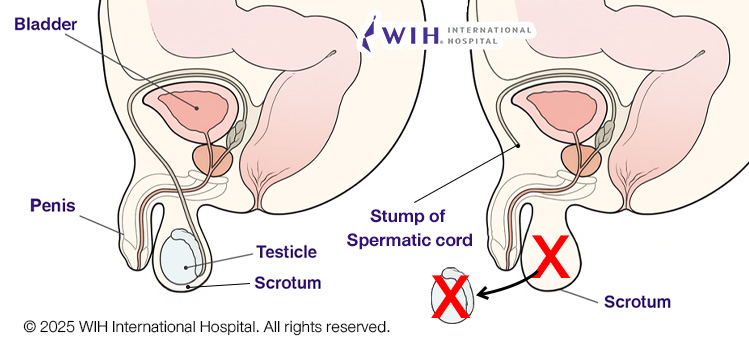Why Patients Choose Orchidectomy Without Vaginoplasty
Patients usually fall into three main groups depending on their long-term surgical goals:
Those planning vaginoplasty soon
Those without a clear timeline, but still expecting GAS in the future
Those who do not plan further genital surgery
Important Considerations
Irreversible procedure:
Permanent loss of fertility
Scrotal skin shrinkage risk

Detailed Surgical Procedure
At WIH International Hospital, orchidectomy is performed with meticulous technique to ensure both safety and the preservation of future surgical options:
Anesthesia:
The procedure is performed under either general anesthesia or twilight sedation (intravenous sedation with local anesthesia), managed by our anesthesiology team for maximum safety, comfort, and smooth recovery.
Incision:
The preferred incision is made at the midline of the scrotum, providing excellent exposure, minimal visible scarring, and optimal preservation of surrounding tissues.
Removal of testicle and spermatic cord:
spermatic cord, and the stump is ligated as close as possible to the external inguinal ring to prevent residual androgen activity.
Spermatic cord contents:
The cord contains the vas deferens, the testicular vessels (artery and pampiniform plexus of veins), and nerves. Careful dissection is performed to avoid injury to surrounding structures.
Concurrent pathology removal:
If abnormalities such as varicocele (dilated veins) or lipoma of the cord are found, these can be safely removed during the same surgery.
Pain prevention:
A cautery cut is routinely used when dividing the cord, reducing the risk of neuropathic pain caused by neuroma formation.
Scrotal skin preservation:
In every case, the scrotal skin is preserved carefully for potential future use in gender-affirming surgery, such as skin-graft vaginoplasty.
Post-operative care:
A pressure dressing is applied to the scrotal area immediately after surgery. This helps minimize bleeding and prevents prolonged swelling, ensuring smoother recovery.




